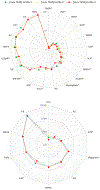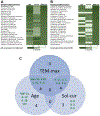Association of occupational exposures with ex vivo functional immune response in workers handling carbon nanotubes and nanofibers
- PMID: 32031476
- PMCID: PMC7121920
- DOI: 10.1080/17435390.2020.1717007
Association of occupational exposures with ex vivo functional immune response in workers handling carbon nanotubes and nanofibers
Abstract
The objective of this study was to evaluate the association between carbon nanotube and nanofiber (CNT/F) exposure and ex vivo responses of whole blood challenged with secondary stimulants, adjusting for potential confounders, in a cross-sectional study of 102 workers. Multi-day exposure was measured by CNT/F structure count (SC) and elemental carbon (EC) air concentrations. Demographic, lifestyle and other occupational covariate data were obtained via questionnaire. Whole blood collected from each participant was incubated for 18 hours with and without two microbial stimulants (lipopolysaccharide/LPS and staphylococcal enterotoxin type B/SEB) using TruCulture technology to evaluate immune cell activity. Following incubation, supernatants were preserved and analyzed for protein concentrations. The stimulant:null response ratio for each individual protein was analyzed using multiple linear regression, followed by principal component (PC) analysis to determine whether patterns of protein response were related to CNT/F exposure. Adjusting for confounders, CNT/F metrics (most strongly, the SC-based) were significantly (p < 0.05) inversely associated with stimulant:null ratios of several individual biomarkers: GM-CSF, IFN-γ, interleukin (IL)-2, IL-4, IL-5, IL-10, IL-17, and IL-23. CNT/F metrics were significantly inversely associated with PC1 (a weighted mean of most biomarkers, explaining 25% of the variance in the protein ratios) and PC2 (a biomarker contrast, explaining 14%). Among other occupational exposures, only solvent exposure was significant (inversely related to PC2). CNT/F exposure metrics were uniquely related to stimulant responses in challenged whole blood, illustrating reduced responsiveness to a secondary stimulus. This approach, if replicated in other exposed populations, may present a relatively sensitive method to evaluate human response to CNT/F or other occupational exposures.
Keywords: Carbon nanotubes; carbon nanofibers; epidemiology; immunosuppression; nanomaterials.
Conflict of interest statement
Disclosure of interest
The authors report no conflict of interest.
Figures



Similar articles
-
Association of pulmonary, cardiovascular, and hematologic metrics with carbon nanotube and nanofiber exposure among U.S. workers: a cross-sectional study.Part Fibre Toxicol. 2018 May 16;15(1):22. doi: 10.1186/s12989-018-0258-0. Part Fibre Toxicol. 2018. PMID: 29769147 Free PMC article.
-
Exposure assessments for a cross-sectional epidemiologic study of US carbon nanotube and nanofiber workers.Int J Hyg Environ Health. 2018 Apr;221(3):429-440. doi: 10.1016/j.ijheh.2018.01.006. Epub 2018 Jan 11. Int J Hyg Environ Health. 2018. PMID: 29339022
-
Carbon nanotube and nanofiber exposure and sputum and blood biomarkers of early effect among U.S. workers.Environ Int. 2018 Jul;116:214-228. doi: 10.1016/j.envint.2018.04.004. Epub 2018 Apr 23. Environ Int. 2018. PMID: 29698898 Free PMC article.
-
Human exposure to carbon-based fibrous nanomaterials: A review.Int J Hyg Environ Health. 2016 Mar;219(2):166-75. doi: 10.1016/j.ijheh.2015.12.005. Epub 2015 Dec 23. Int J Hyg Environ Health. 2016. PMID: 26752069 Review.
-
Focused actions to protect carbon nanotube workers.Am J Ind Med. 2012 May;55(5):395-411. doi: 10.1002/ajim.22028. Epub 2012 Mar 5. Am J Ind Med. 2012. PMID: 22392774 Review.
Cited by
-
Indirect mediators of systemic health outcomes following nanoparticle inhalation exposure.Pharmacol Ther. 2022 Jul;235:108120. doi: 10.1016/j.pharmthera.2022.108120. Epub 2022 Jan 24. Pharmacol Ther. 2022. PMID: 35085604 Free PMC article. Review.
-
Occupational Exposures to Engineered Nanomaterials: a Review of Workplace Exposure Assessment Methods.Curr Environ Health Rep. 2021 Sep;8(3):223-234. doi: 10.1007/s40572-021-00316-6. Epub 2021 Jun 8. Curr Environ Health Rep. 2021. PMID: 34101152 Free PMC article. Review.
-
Histopathology of the broad class of carbon nanotubes and nanofibers used or produced in U.S. facilities in a murine model.Part Fibre Toxicol. 2021 Dec 20;18(1):47. doi: 10.1186/s12989-021-00440-z. Part Fibre Toxicol. 2021. PMID: 34923995 Free PMC article.
-
Physicochemical characterization and genotoxicity of the broad class of carbon nanotubes and nanofibers used or produced in U.S. facilities.Part Fibre Toxicol. 2020 Dec 7;17(1):62. doi: 10.1186/s12989-020-00392-w. Part Fibre Toxicol. 2020. PMID: 33287860 Free PMC article.
-
Biocompatibility of nanomaterials and their immunological properties.Biomed Mater. 2021 Mar 11;16(4):10.1088/1748-605X/abe5fa. doi: 10.1088/1748-605X/abe5fa. Biomed Mater. 2021. PMID: 33578402 Free PMC article. Review.
References
-
- Aragon MJ, Topper L, Tyler CR, Sanchez B, Zychowski K, Young T, Herbert G, et al. 2017. “Serum-Borne Bioactivity Caused by Pulmonary Multiwalled Carbon Nanotubes Induces Neuroinflammation via Blood-Brain Barrier Impairment.” Proceedings of the National Academy of Sciences 7;114: E1968–E1976. - PMC - PubMed
-
- Birch ME, et al., 2017. Analysis of Carbon Nanotubes and Nanofibers on Mixed Cellulose Ester Filters by Transmission Electron Microscopy Chapter CH in: NIOSH Manual of Analytical Methods (NMAM), 5th ed. U.S. Department of Health and Human Services, Centers for Disease Control and Prevention, National Institute for Occupational Safety and Health, DHHS (NIOSH), Cincinnati, OH.
Publication types
MeSH terms
Substances
Grants and funding
LinkOut - more resources
Full Text Sources
Other Literature Sources
Medical
Research Materials
Miscellaneous
